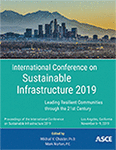International Conference on Sustainable Infrastructure 2019
Construction Information Management Systems: Conceptual Model to Improve Residential Construction Project Resilience and Productivity in New Zealand and Saint Vincent and the Grenadines
Publication: International Conference on Sustainable Infrastructure 2019: Leading Resilient Communities through the 21st Century
ABSTRACT
The residential construction sectors in New Zealand and Saint Vincent and the Grenadines are plagued by low productivity levels and inefficient information management; exacerbated by the effects of climate change-related hazards and extreme weather events. Previous studies only recommend ways to partially mitigate some of these challenges and risks. The author aimed to model construction information management systems that can improve the productivity and resilience of residential construction projects in NZ and SVG. A convergent parallel mixed methods design was used to collect qualitative and quantitative data. The author developed an original conceptual model, termed “Agile Residential Construction Information Management System (ARCIMS)” that represents an agile approach to the management of information during the execution of projects. The ARCIMS model will serve as a foundation for the further development of CIMS that could contribute to more efficient and resilient residential construction in hazard-prone areas.
Get full access to this chapter
View all available purchase options and get full access to this chapter.
REFERENCES
Andrew Barker. (2017). Improving productivity in New Zealand's economy. Paris: OECD Publishing. ProQuest Entrepreneurship https://doi.org/10.1787/8071e193-en
Abbott, M., & Carson, C. (2013). A comparative approach to determining the growth of productivity of the New Zealand construction industry. Australasian Journal of Construction Economics and Building, The, 13(4), 65-77. https://search.informit.com.au/documentSummary;dn=777630978038933;res=IELBUS
Buckett, N. R. (2014). Advanced residential construction techniques - opportunities and implications for New Zealand. study report SR 311. Judgeford: BRANZ Ltd. https://www.branz.co.nz/cms_show_download.php?id=4a8fe57f274e0906d2c312acc538db1187fa89d7
Centre for Systems Philosophy (2014). The development and status of systems philosophy Retrieved from http://www.systemsphilosophy.org/history-and-development-of-systems-philosophy.html
Chang-Richards, A., Wilkinson, S., Seville, E., & Brunsdon, D. (2016). Capacity and capability development. Canterbury subcontracting businesses: Features, motivating factors and obstacles; Christchurch: Resilient Organisations Research Report. https://www.resorgs.org.nz/wp-content/uploads/2017/07/resorgs-research-report-2016-03-subcontractors-features.pdf
Chang-Richards, Y., Wilkinson, S., Seville, E., & Brunsdon, D. (2017). Effects of a major disaster on skills shortages in the construction industry lessons learned from New Zealand. Engineering Construction and Architectural Management; 24(1), 2-20.
Construction Information Centre (2017). Global construction outlook 2021. London: Timetric. Retrieved from https://www.timetricreports.com/report/cn0004go--global-construction-outlook-2021/
Curtis, M. D. (2013). Small firms' work types and resources. study report SR 284. Judgeford: BRANZ Ltd. https://www.branz.co.nz/cms_show_download.php?id=9bf0426d3bf5e9e1444433a48c9d1859502736dc
Curtis, M. D., & Page, I. C. (2014). Small construction firms in New Zealand. study report SR 315. Judgeford: BRANZ Ltd. https://www.branz.co.nz/cms_show_download.php?id=d0531d0312781dd0131e7157a44599d7c29a3556
Durdyev, S., & Mbachu, J. (2011). On-site labour productivity of New Zealand construction industry: Key constraints and improvement measures. Australasian Journal of Construction Economics and Building, The, 11(3), 18-33. https://search.informit.com.au/documentSummary;dn=420783685347817;res=IELBUS
Eckstein, D., Künzel, V., & Schäfer, L. (2017). Global climate risk index 2018: who suffers the most from extreme weather events? weather-related loss events in 2016 and 1997 to 2016. Berlin: Germanwatch e.V. https://germanwatch.org/en/download/20432.pdf
Gonsalves, R. (2017). Budget address 2017. Kingstown: Office of the Prime Minister. http://finance.gov.vc/finance/images/PDF/budgetaddress/budget_address_and_econ_review_combine_2017-11.pdf
Green, B. (2016). Productivity in construction: Creating a framework for the industry to thrive. Berkshire: The Chartered Institute of Building. https://policy.ciob.org/wp-content/uploads/2016/05/CIOB-Productivity-report-2016-v4_single.pdf
Jasper Mbachu, Temitope Egbelakin, Eziaku Onyeizu Rasheed, & Wajiha Mohsin Shahzad. (2017). Influence of key role players on productivity outcomes in the residential building lifecycle. Journal of Engineering, Design and Technology, 15(4), 528. https://search.proquest.com/docview/1929857644
Marín, N., Vila, M. A., & Martínez-Rojas, M. (2016). The role of information technologies to address data handling in construction project management. Journal of Computing in Civil Engineering, http://ascelibrary.org/doi/abs/10.1061/(ASCE)CP.19435487.0000538
MBIE. (2013). Residential construction sector market study - issues paper. Wellington: MBIE. http://www.mbie.govt.nz/info-services/building-construction/documents-and-images-library/residential-construction-sector-market-study-/Residential%20Construction%20Sector%20Study%20-%20Issues%-20Paper.pdf
MBIE. (2017). National construction pipeline report 2017 - a forecast of building and construction activity. Wellington: MBIE. http://www.mbie.govt.nz/publications-research/research/construction-sector-productivity/national-construction-pipeline-report-2017.pdf
McKinsey Global Institute. (2017). Reinventing construction: A route to higher productivity. New York City: McKinsey & Company. https://www.mckinsey.com/~/media/McKinsey/Industries/Capital%20Projects%20and%20Infrastructure/Our%20Insights/Reinventing%20construction%20through%20a%20productivity%20revolution/MGI-Reinventing-construction-A-route-to-higher-productivity-Full-report.ashx
MGI. (2014). A blueprint for addressing the global affordable housing challenge. New York City: McKinsey & Company. http://globalhousingindicators.org/sites/globalhousingindicators.org/files/McKinsey%20Global%20Institute%20Full%20Report.pdf
PwC. (2016). Valuing the role of construction in the New Zealand economy: A report to the construction strategy group in association with construction industry council and BRANZ - final report. Auckland: PwC. https://www.pwc.co.nz/pdfs/CSG-PwC-Value-of-Construction-Sector-NZ.pdf
Sapeciay, Z., Wilkinson, S., & Costello, S. B. (2017). Building organisational resilience for the construction industry. International Journal of Disaster Resilience in the Built Environment, 8(1), 98-108.
Serdar Durdyev, & Jasper Mbachu. (2011). On-site labour productivity of New Zealand construction industry: Key constraints and improvement measures. Construction Economics and Building, 11(3), 18-33., https://doaj.org/article/0aecef4e69ae41bd94ecedf6babf47d9
WEF. (2016). Shaping the future of construction: A breakthrough in mind set and technology. Geneva: World Economic Forum.
Wilkinson, S., Chang-Richards, A. Y., Sapeciay, Z., & Costello, S. B. (2016). Improving construction sector resilience. International Journal of Disaster Resilience in the Built Environment, 7(2), 173-185.
Information & Authors
Information
Published In
International Conference on Sustainable Infrastructure 2019: Leading Resilient Communities through the 21st Century
Pages: 205 - 215
Editors: Mikhail V. Chester, Ph.D., Arizona State University, and Mark Norton, Santa Ana Watershed Project Authority
ISBN (Online): 978-0-7844-8265-0
Copyright
© 2019 American Society of Civil Engineers.
History
Published online: Nov 4, 2019
Authors
Metrics & Citations
Metrics
Citations
Download citation
If you have the appropriate software installed, you can download article citation data to the citation manager of your choice. Simply select your manager software from the list below and click Download.
